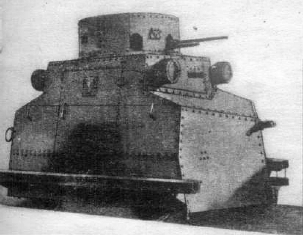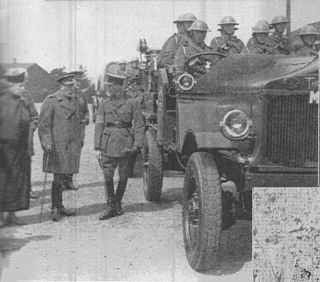 W
WThe Arsenal Crossley was an Estonian armored car that was operated between 1926 and 1940. At the time it was introduced the Arsenal Crossley was one of the most modern armored vehicles in the Estonian Army. The vehicle's name is the combination of the two factories that contributed to its production. The car was manufactured in Estonia's Arsenal factory, while the engine was provided by the British company Crossley Motors Ltd and the armored plates were ordered from Sweden.
 W
WThe Carden Loyd tankettes were a series of British pre-World War II tankettes, the most successful of which was the Mark VI, the only version built in significant numbers. It became a classic tankette design worldwide, was licence-built by several countries and became the basis of several designs produced in various countries.
 W
WThe Ford FT B was the first armoured car designed and built in Poland. Built on the chassis of the Ford T and armoured with re-used armoured plates, the car was a successful design for its time. The main designer was the engineer Tadeusz Tański. The armoured vehicle originated on account of the high demand during the Polish-Soviet war in 1920.
 W
WThe Jeffery Quad, also known as the Nash Quad or Quad is a four-wheel drive, 11⁄2-ton rated truck that was developed and built by the Thomas B. Jeffery Company from 1913 in Kenosha, Wisconsin, and after 1916 by Nash Motors, which acquired the Jeffery Company. Production of the Quad continued unchanged through 1928.
 W
WThe Lanchester 6x4 armoured car was a British armoured car with a 6x4 drivetrain produced in limited numbers in the late 1920s and early 1930s. A heavier, more rugged development of the earlier Lanchester 4x2 armoured car, it remained in service with Territorial and colonial units until the early 1940s and saw action in the Battle of Malaya.
 W
WThe OA vz. 27 was a Czechoslovak-designed armored car used by Nazi Germany, Slovakia, and Romania during World War II. Fifteen were built, of which the Germans seized nine when they occupied Bohemia-Moravia in March 1939 and the Slovaks captured three when they declared independence from Czechoslovakia at the same time. Romania acquired three when Czech troops sought refuge in Romania after the Hungarian invasion of Carpatho-Ukraine that same month. All were used for training or internal security duties during the war.
 W
WSamochód pancerny wz. 28 was a Polish armoured car of the 1920s. Based on French-built Citroën-Kegresse B2 10CV half-track chassis, the vehicle became the standard armoured car of the Polish Army. However, due to low speed and problems with reliability, already in 1933 it was decided to return the completed wz. 28 armoured cars to the factory and rebuild them as all-wheel Samochód pancerny wz. 34.
 W
WSamochód Pancerny wzór 29, commonly known as Ursus or CWS, was a Polish interwar heavy armored car. A handful of these vehicles saw combat during the Polish-German War of 1939.
 W
WThe Tatra T18 was a Czechoslovakian draisine designed and manufactured by Tatra in the 1920s.
 W
WThe Hathi was an early four wheel drive lorry built by Thornycroft in the 1920s. It was used by the British Army as an artillery tractor.
 W
WThe Vickers 6-Ton Tank or Vickers Mark E was a British light tank designed as a private project at Vickers. It was not purchased by the British Army, but was picked up by many foreign armed forces. It was licensed by the Soviets as the T-26. It was also the direct predecessor of the Polish 7TP tank.
 W
WThe Vickers Crossley Armoured Car a/k/a the Model 25 Vickers Crossley armoured car, was a British-made military vehicle used by the British Army in India and exported to different countries, including Japan.